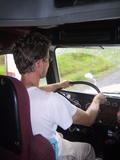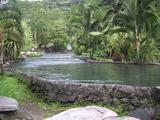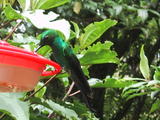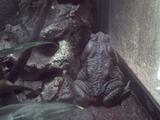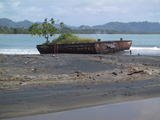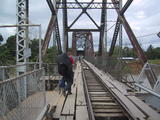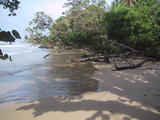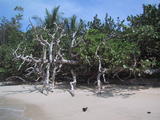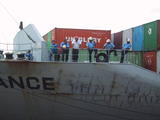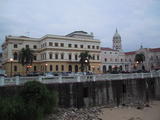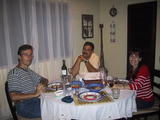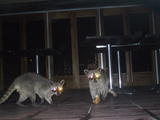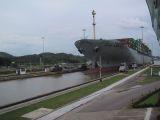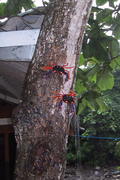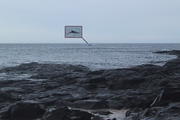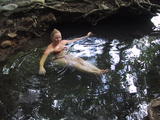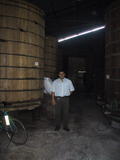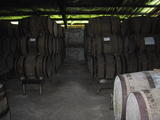| < < < Previous story | Next story > > > | |
Costa Rica & PanamaNormandy, 28 July 2003
Contents:La FortunaWe left Ometepe on the 24th of June, together with two girls from Minnesota, Mary-Rae and Lizbeth. We all wanted to go to La Fortuna in Costa Rica, near the Arenal volcano. After a 2.5 hour drive by bus, a one-hour ferry trip and a 45 min taxi ride, we arrived at the border. The Nicaraguan border guards charged us 4 dollars to leave the country and refused to accept payment with the equivalent in Cordobas. Mary and Liz, started to talk with Tito a Guatemalan truck driver and his wife Marleny. An incredibly friendly couple who offered us a ride in their truck all the way to La Fortuna. I never knew how much space there was in a truck cabin, it was enough for the 4 of us, plus our backpacks! A funny thing was, that I found it much easier to understand the Spanish spoken by Tito and Marleny than I did that spoken by Nicaraguans, maybe we have learned a Guatemalan version of Spanish while staying in Antigua. The truth is though that Guatemalans pronounce words more clearly and talk slower, which is one of the reasons why Guatemala is a popular destination for people wanting to learn Spanish. While talking with Tito he suddenly asked me if I wanted to drive the truck for a while. I hesitated a bit. There was hardly any traffic and the road was of such bad quality that we hardly drove faster than 20km per hour. So I decided to try it. Tito let me drive for 15 to 20 minutes. With centimeters on each side I managed to cross single lane bridges on which his large truck hardly fit. It was the first time ever I drove a truck. We spent two days in La Fortuna, close to Arenal, Central America's most active volcano. Unfortunately it was clouded all the time, and we never really saw anything, but we did hear a very loud explosion while we spent a relaxing afternoon in the hot water pools near the hot springs. MonteverdeFrom La Fortuna we moved on to Monteverde, famous for its rain forests. The first thing we visited was the Monteverde Cloud Forest Reserve. Taking the early bus we arrived 10 minutes before the park opened. The entry fee, for what is basically just a walk through the forest, was a rip off at 12 USD per person, so we pulled out our Guatemalan ISIC cards and got a 50% reduction. Costa Rica is more expensive than other Central American countries, but fortunately they often have rates for students, anywhere from 20% to 50% lower. Since we had been full time Spanish students in Antigua Guatemala we had acquired a ISIC cards. One of the reasons the reserve had been created was to protect the Golden Toad. Unfortunately in 1988 they suddenly disappeared, their numbers dwindling from about 1500 in 1987 to 1 in 1988. The cause of their disappearance remains a mystery but the same year nearly half of all the frog species in the region disappeared. It was a good thing that we started so early because after two hours of walking we encountered large groups of loud tourists, which not only annoyed us but certainly scared away any animal that was still in the neighborhood. The first two hours we had heard many birds and saw hummingbirds fly around us. Just outside the park hummingbird feeders attract the birds and provide a good opportunity to photograph them, they only exist in the Americas and are amazing to see. There is also a lot of secondary rain forest in the area, which is land that has been returned to nature and is now again rain forest. Obviously this did not happen so long ago, so there are very few large trees in the secondary rain forests. We got a great tour at the butterfly farm, where we were told about the leafcutter ants (that we had seen so abundantly on Ometepe) and the life cycle of the butterfly. We were also told about the tarantula wasp, it seems that these wasps sting tarantulas with a sting that puts them in a coma, but does not kill them, the wasps then try to hide the tarantula and lay their eggs in them. After hatching the larva start by eating all the non vital organs, trying to keep the tarantula alive as long as possible in order to keep their food fresh! Interesting stuff that nature has come up with. This reminded me of our encounter with a tarantula near Semuc Champey. The tarantula was occupying a bathroom in the hostel. Fortunately there were two bathrooms, the other was occupied by two frogs, so we used that one. Two other attractions in Santa Elena are the Orchid Garden and the Frog Pond. The frogs varied in size from that of a human hand to the size of a thumb and exist in many different colors: brown, green, red and blue. In the Orchid Garden some of the orchids were so small that we needed a magnifying glass to see them. San JoseFrom Santa Elena we traveled to San Jose on the 06:30 bus. We spent two days in San Jose, where we were fortunate enough to find a one way ticket back to Amsterdam for 467 USD (approx. 400 EUR), while our ticket from Amsterdam to Guatemala City had cost 730 EUR per person. A good bargain, so we booked it for July 21st. We did not see much of San Jose, the center is a pedestrian zone, reminding us of many cities in Europe. Some areas outside the city center are not that safe. We went to the cinema in San Pedro, the university area. It was just like a good cinema in Europe or the US would be, modern, clean, good sound, nice seats, eating popcorn and drinking large drinks, we almost forgot that we were in Central America. English language movies are not dubbed but subtitled. A good thing, as I never liked to see movies dubbed in French or German when I lived in Strasbourg. I always preferred to see the original version as is usual in the Netherlands and other smaller European countries. Puerto ViejoTraveling on by bus we arrived in Puerto Viejo on the Caribbean coast, where we stayed in a little hotel owned by a Swiss couple from the French speaking part of Switzerland. They had settled there some years ago, to start a little hotel. They are actively fighting the uphill battle to keep Puerto Viejo clean. A difficult task, since the habit of throwing garbage on the street while walking or driving is widespread. To us this is probably the most annoying thing we experienced in Central America. Every time somebody threw a bottle or wrapper out of the window of the bus, we felt like saying: "Why do you make your own country dirty? Don't you like your own country? Don't you want tourists to come here anymore? Or do you like to walk around in a garbage dump?" Meanwhile we put our garbage in a plastic bag that we carried along and hoped some of them might learn from our example. Bocas del ToroFrom Puerto Viejo, we took the bus to the Panamanian border. We had to cross the border river by walking over a single track rail bridge, also used by cars and trucks all driving on wooden planks laid on the bridge. The very unclear information about needing a $10 tourist card or not to enter Panama, proved not to apply to people carrying Dutch passports. Being unaccustomed to crossing borders for free and fast in Central America, we were surprised how quickly we found ourselves on the other side waiting for the bus. We spent most of the time there saying no to touts, offering their "services" to bring us to Bocas del Toro for "only" $10 per person, while the buses and boat ride eventually cost us a total of $2.70 per person, was of good quality and fast. Usually prices in US dollars are a sign of a rip off, but Panama uses the US dollar since 1904, and never had a financial crisis, or high inflation as a result. In Bocas del Toro, we went on a night excursion to see sea turtles nest on the beach. The excursion is organized by a charity that patrols the beach to protect the turtles. Alas the night that we went, no turtles showed up, but we did see the "footprints" of a previous turtle. Another trip, brought us to see dolphins and do some snorkeling, unfortunately every operator in town does the same tour at the same time and in the same sequence, so there were always 4 other boats not far away. During one of the snorkeling excursions I saw a crab hiding under coral, that was huge. I only saw the left side, but could clearly see its 4 left legs and one of the claws (if that's what you call them). The legs were about 30cm and the body itself something similar. I hovered about it for about 10min, but strangely enough it did not move at all. The town of Bocas del Toro does not really have any good beaches, for beaches go to Bastimentos by boat and walk across the island. Some of the beaches are nearly deserted. Unfortunately, I tripped and seriously bruised my toe while getting out of the water, the toe folded under my foot with all my body weight on it while I fell. A very painful experience, which later made my toe display a whole new gamut of colors... Already having walking difficulties with the other leg, this was not convenient as we had to walk back across the island over muddy and slippery paths. After spending the rest of the day and a large part of the next day in a hammock with my feet up and my toe covered with ice while reading Ayn Rand's Atlas Shrugged, I recovered a bit. Panama CityFrom Bocas we flew to Panama City. Panama City is strikingly different from any other town we have visited in Central America. It is very modern and a lot cleaner, it has a large skyscraper district. It gave me the impression that it could be a city in the United States. The hotels in the area where we stayed advertise with being open 24 hours which suggests that they cater to another market segment as well... We visited the Panama Canal locks at Miraflores, where you can watch giant ships pass through the locks, being lowered to sea level or raised from it. Impressive. 200.000 cubic meters of fresh water from lake Gatun is needed for every boat that passes the canal. What's also impressive is the price the boats pay to pass, an average of 35.000 USD! We already had some friends in Panama City. Emilio and Julietta, a Panamanian-Argentinean couple we met in Bocas del Toro, came back to Panama City and invited us to a wonderful dinner at their home. Later we went for a drink on the last island connected to the mainland by a causeway built from the rubble that was removed from the canal during its construction. We also had dinner with Angela, a South-Korean girl we knew from Antigua. She is also a good friend of Claudia, whose house we lived in in Antigua. So we spent a lot of time talking about life in Antigua. After 5 days in Panama City, we had to start going back towards San Jose to catch our flight. First we went to Pedasi, a little town in the south of Panama. We spent a day on Isla Iguana, from the island we saw whales playing in the distance, and others passing really close to the beach. From the boat I finally saw a real life sea-turtle. We got a ride out of Pedasi with George and Irena, a couple from the US who spend many months a year in Panama. They dropped us off at a convenient location to catch the bus to David. We spent another day in David visiting a local rum-distillery and lingering around in some hot springs nearby. On Saturday, 19th of July we took the bus to San Jose. Back to EuropeThe next day after forking out 26 USD per person to leave Costa Rica we had an uneventful flight back to Amsterdam. Only the stopover in Miami was weird, as we had to go through customs and then had to walk back through the exact same corridors to the airplane. Why bother? We will spend two months in Europe, first two weeks in Holland and France after which we will drive to the Balkans and then north to Estonia. Where we will be during the referendum on E.U. membership, for which Maris can also vote. Around the end of September we will again leave Europe for either South-America or Southeast-Asia. The most likely destination is South-America so that we can be in Patagonia in December or January and enjoy the southern summer. If you want to be notified when we write more about our trip, just send us an E-mail. e-mail Otto de Voogd PhotosCosta RicaBocas del ToroPanama CityPanama Canal Slide ShowPedasiDavidPractical Information
To my knowledge the information provided here was accurate
at the time of our visit. However time passes and things can change.
Money(ATMs for Maestro/Cirrus bankcards)
Costa Rica: ATMs of some banks in San José
CostsCosta Rica - Colon, approx. rates: 1 USD = 390 CRC, 1 EUR = 460 CRC
Santa Elena/Monte Verde: The newly opened, cozy and clean, Pension Sinai,
tel: 645-5343, 828-2094, e-mail: lucreciajc@yahoo.com.
It is run by the very friendly Lucrecia and is probably the best deal in town
at 5 USD per person.
Panama - US Dollar, approx. rate: 1 EUR = 1.17 USD
Bus & Boat: Costa Rican border -> Bocas del Toro: 2.70 USD.
Costa Rica - Colon, approx. rates: 1 USD = 390 CRC, 1 EUR = 460 CRC
Flight: San Jose -> Amsterdam with Martinair: 467 USD one way.
From the OTEC travel agent in San Jose.
| ||
| < < < Previous story | Next story > > > | |
New | About | Contact | Connect | Friends | Promotions | Copyright | Advertise
